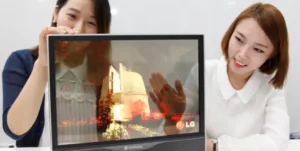We have reported on transparent and flexible displays before, so look at the commentary if you are familiar with the topic.
Business Korea, published an interview with an official from LG and according to the report, the Korean display giants LG Display and Samsung Display hold about a 50% global market share. While they are market leaders today, they also work on new technologies that will allow them to retain their market leadership in coming years.
According to the article, these technologies are flexible and transparent displays. Both displays have been developed over the past few years and have been introduced in some commercial products. While the flexible displays have been used in mobile devices, the transparent type has been offered in professional display applications.
Source: Business Korea
In the interview, LG defined the stages of flexible displays as curved, bended, foldable and rollable. The company sees the displays from LG and Samsung between the first and second stage. The article also quotes a Samsung official saying that a foldable smartphone will be possible by 2016. They also see that the application of flexible displays will exceed smartphones and wearables in coming years.
Analyst Comment
This seems pretty optimistic when it comes to flexible display technology. So far no product has been shown that allows the user to change the shape of the display. Nevertheless, tests of rolling a display around a defined radius several thousand times have been shown already. A foldable display requires a pretty small radius that has to be bent for 180 degrees, which is more than has been have seen so far but is not a very big step.
The transparent display, as shown in the image above, is somewhat of an oddity in the display field. When we describe displays we look at image quality as one of the key factors. Image quality is a combination of many factors that we describe in the form of key parameters, such as display size, pixel density, brightness, contrast ratio and others. When it comes to contrast ratio, a transparent display is somewhat of a weird concept. We can look through and see the resulting image at the same time. Brightness and contrast ratio depend on the lighting conditions behind the image.This means high brightness objects can be seen better than dark objects that can only be as dark as the background illumination.
So far the only viable applications have been transparent refrigerators and product showcases. These are not high volume applications to start out with and use in consumer grade refrigerators has not been able to gain significant market share. Now there is a new use being proposed for the technology in head up displays (HUDs). It has also been suggested that using transparent displays on the windshield of a vehicle could replace the current projection systems. A very interesting and low cost concept. There are two drawbacks with this approach. First of all the current transparent displays have a transmittance of about 10%, even though the most recent LG and Samsung panels reach 30%. Samsung had announced before that it will soon reach 50% transmittance (as we reported from ISE- Man. Ed.). Still this is too low for use in a windshield application as there are local laws regulating the minimum transmittance level of a windshield. Typically this is around 75% in the USA, still significantly higher than what LG can reach today.
There is also the issue of focus. While current HUDs create an image that is focused ahead of the car, a transparent display would require focus on the windshield and as such negating some of the advantages of a HUD.The issue of focus is important for the proponents of the head up display technology. Eye focus takes time and the projection based HUD in the current form allows the driver to keep the eye focused on the far distance. This may save important fractions of a second in case of an emergency.
However, this does not mean that such applications will be explored going forward. For transparent displays to drive display sales, a mass market product has to adopt this technology. So far applications benefiting from a transparent display technology have not been found and we have to see if automotive applications can fill this void. – NH
While Norbert is sceptical, I am much more optimistic. The “tri-fold” tablet that Samsung Display has been showing, most recently at CES and MWC, is very impressive, although the bend radius is not quite there yet. On the other hand, as we report elsewhere, FlexEnable (FlexEnable Looking at New OLED & LCD Applications) now has transistor arrays that can be bent around a matchstick. (BR)

